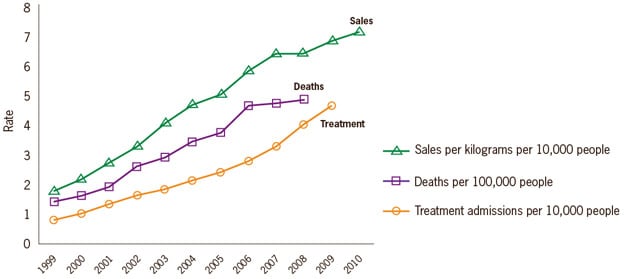More Americans die annually from prescription painkiller overdoses than the combined total for cocaine and heroin, according to a new CDC Vital Signs report released today. Narcotic painkillers, such as Opana (oxymorphone), OxyContin (oxycodone), methadone, and Vicodin (hydrocodone) are killing over 40 people in the USA every day due to overdose. CDC Director Thomas Frieden, M.D., M.P.H, said:
“Overdoses involving prescription painkillers are at epidemic levels and now kill more Americans than heroin and cocaine combined. States, health insurers, health care providers and individuals have critical roles to play in the national effort to stop this epidemic of overdoses while we protect patients who need prescriptions to control pain.”
A significant proportion of deaths are from people who obtain prescription painkillers without a prescription. The aim being to experience the “high” these medications can give. In other words, using prescription painkillers for recreational use.
The National Survey on Drug Use and Health, USA, informs that in 2010 approximately 1 in every 20 individuals over the age of 12 years said they used prescription painkillers for non-medical reasons (recreationally) – a total of 12 million people. The DEA (Drug Enforcement Agency) says that sales of such medications to health care providers and pharmacies have gone up by over 300% during the last twelve years.
Rates of prescription painkiller sales, deaths and substance abuse treatment admissions (1999-2010)

Source:
Gil Kerlikowske, Director of National Drug Control Policy, said:
“Prescription drug abuse is a silent epidemic that is stealing thousands of lives and tearing apart communities and families across America. From day one, we have been laser-focused on this crisis by taking a comprehensive public health and public safety approach.
All of us have a role to play. Health care providers and patients should be educated on the risks of prescription painkillers. And parents and grandparents can take time today to properly dispose of any unneeded or expired medications from the home and to talk to their kids about the misuse and abuse of prescription drugs.”
The Obama Administration launched an action plan – Epidemic: Responding to America’s Prescription Drug Abuse Crisis – in April this year to tackle “the national prescription drug abuse epidemic”. Authorities say they aim to reduce “this public health burden”.
State-based monitoring programs will be expanded under this plan. Unused medicatios will be disposed of more easily and in a more environmentally friendly way, authorities say. There will also be education for healthcare providers and their patients, as well as stronger support for law enforcement agencies.
State-based monitoring programs are already underway in 48 states with the aim to stop these prescription painkillers being diverted, while at the same time respecting patients’ privacy. The DoJ (Department of Justice) has already closed in on several “pill mills”.
A Pill Mill is a clinic, doctor’s office, or health care facility that routinely conspires in the prescribing and dispensing of controlled substances outside of the prevailing standards of medical practice in the community, or violates the laws of the state regarding the prescribing or dispensing of controlled prescription drugs. Put more simply and crudely – a pill mill is a place where people can easily obtain prescription medications for money, whether they need them or not.
Death rates by state from drug overdoses, per 100,000 people (2008)

Source:
The Secure and Responsible Drug Disposal Act, which was signed into law by President Obama, allows local communities and states to collect and safely get rid of unwanted prescription medications. Over the past year the DEA has collected and disposed of more than 300 tons of unwanted drugs.
Pamela Hyde, Substance Abuse and Mental Health Services Administration Administrator, said:
“Almost 5,500 people start to misuse prescription painkillers every day. Just like other public health epidemics, community-based prevention can be a proven, life-saving and cost-effective key to breaking the trend and restoring health and well-being.”
Below are some highlighted data from the report:
- Death rates from prescription painkillers are three times higher among non-Hispanic whites than for African-Americans and Hispanic whites
- Death rates among Alaskan Natives and American Indians are about the same as they are for non-Hispanic whites
- The highest death rates are among people aged between 35 and 54 years
- 830,652 years of potential life before the age of 65 were lost in one year because of prescription painkiller overdoses
- Overdoses from prescription painkillers destroy a similar number of years of potential life lost to those from road accidents, and significantly more that those lost due to homicide
- According to 2008 data, death rates from prescription medication overdoses range from a low of 5.5. per 100,000 individuals in Nebraska to 27 per 100,000 in New Mexico
- 1 in every 12 people aged at least 12 years use prescription painkillers recreationally in Oklahoma, the highest rate in the USA. Nebraska has the lowest rate at 1 in every 30 people.
- Sales of prescription painkillers per head in Florida (highest state) are three times higher than Illinois (lowest state). The higher the sales per person the higher that state’s drug overdose death rate tends to be
Written by Christian Nordqvist